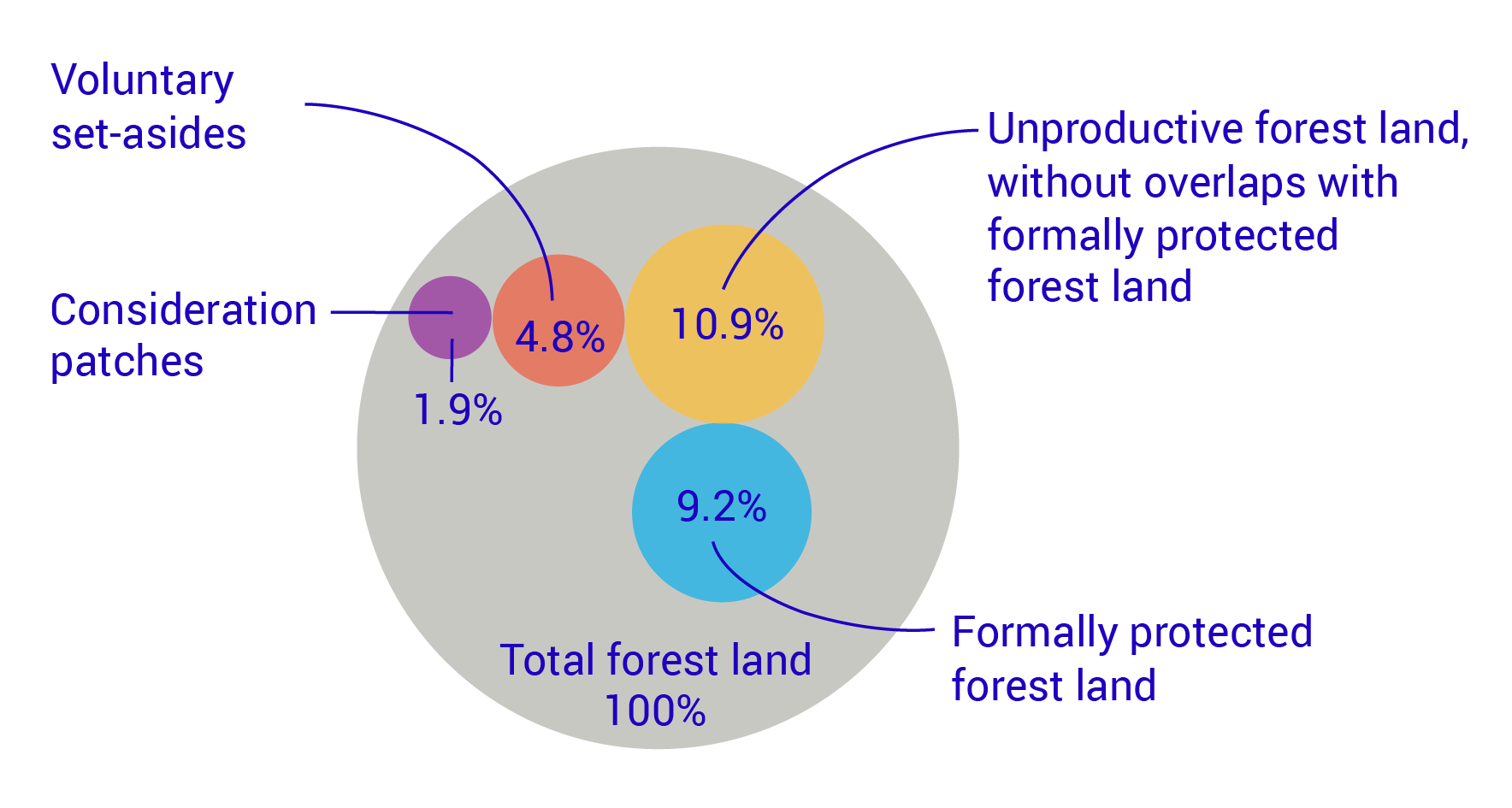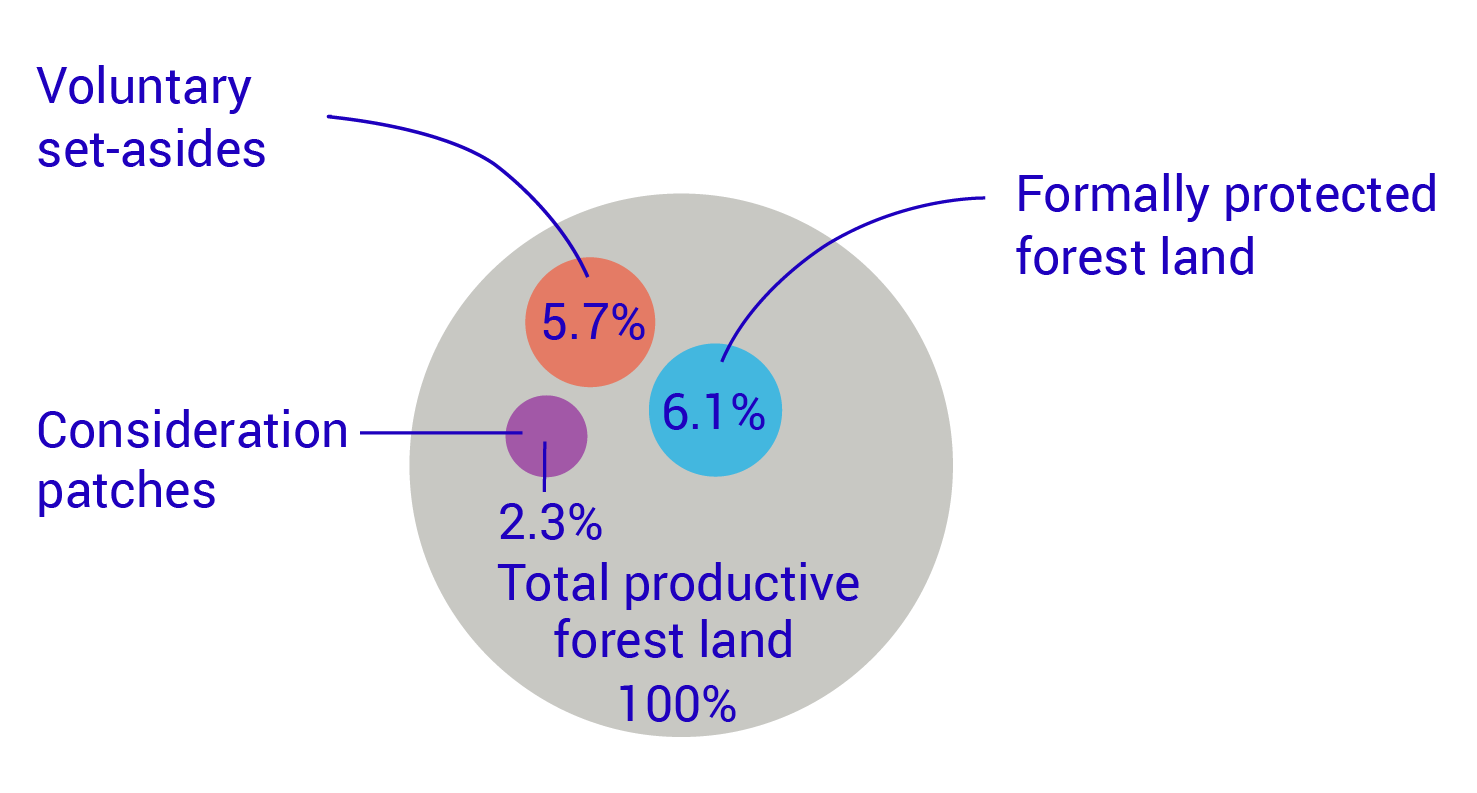Formally protected forest land, voluntary set-asides, consideration patches and unproductive forest land 2023
Increase in formally protected forest land 2023
Statistical news from Statistics Sweden 2024-06-27 8.00
In 2023, formally protected forest land increased by 79 100 hectares. During the same period, the area of voluntary set-asides decreased by 22 200 hectares. The changes are partly due to an agreement between the Swedish Environmental Protection Agency and Sveaskog on the formation of new formally protected areas.
Formally protected forest land amounted to a total of 2.5 million hectares by the end of 2023. That is an increase of 3 percent compared to the 2022 statistics. Out of Sweden's total forest land, 9.2 percent had formal protection.
Unproductive forest land amounted to a total of 4.4 million hectares, including overlap with formally protected forest land. Unproductive forest land without formal protection, amounted to more than 3 million hectares, which is 10.9 percent of Sweden's total forest land area.

Source: Statistics Sweden, the Swedish Environmental Protection Agency, the Swedish Forest Agency, and the Swedish University of Agricultural Sciences National Forest Inventory.
Formal protection on productive forest land amounted to 1.4 million hectares in 2023. That is an increase of 4 percent compared to the 2022 statistics. Out of Sweden's total area of productive forest land, 6.1 percent had formal protection.
Voluntary set-asides amounted to 1.3 million hectares in 2023, which is a decrease of 2 percent compared to the 2022 statistics. The area corresponds to 5.7 percent of Sweden’s total area of productive forest land.

Source: Statistics Sweden, the Swedish Environmental Protection Agency, the Swedish Forest Agency, and the Swedish University of Agricultural Sciences National Forest Inventory.
A preliminary estimate of consideration patches for regeneration felling amounted to an area of more than 0.5 million hectares in 2023, which corresponds to 2.3 percent of Sweden’s total area of productive forest land.
Formally protected forest land, voluntary set-asides, consideration patches and unproductive forest land, 2023
Areas in hectares, rounded to even 100s
| Areas in hectares, without overlapping areas | Share of Sweden’s total forest land | ||||
|---|---|---|---|---|---|
| Forms | Productive forest land | Total forest land | Productive forest land | Total forest land | |
| Formally protected forest land | 1 405 800 | 2 476 800 | 6.1% | 9.2% | |
| Voluntary set-asides | 1 337 800 | 1 337 800 | 5.7% | 4.8% | |
| Consideration patches | 529 600 | 529 600 | 2.3% | 1.9% | |
| Unproductive forest land | 0 | 3 048 300 | 0.0% | 10.9% | |
Source: Statistics Sweden, the Swedish Environmental Protection Agency, the Swedish Forest Agency and the Swedish University of Agricultural Sciences
Definitions and explanations
Forest land
Under the Forestry Act (1979:429), forest land is defined as a coherent area in which trees are higher than five metres and the crown cover is more than ten percent or there are conditions to attain this height and crown cover without production-enhancing measures. This definition has been valid since 2008 when it was changed (SFS 2008:662) in order to harmonize the Swedish definition of forest land with the international one. The area of forest land in Sweden became larger according to the new definition compared to the old one (Loman, 2011).
Productive forest land
Under the Forestry Act, productive forest land is defined as forest land that, according to generally accepted criteria, can produce on average of at least one cubic metre of wood per hectare and year.
Types of forest land
Statistics Sweden presents statistics on four different types of forest land:
1. formally protected forest land,
2. voluntary set-asides,
3. consideration patches for regeneration felling, and
4. unproductive forest land.
They are described in the government assignment (N2018/04159/SK) as the subsets on which these statistics are to be distributed. The statistics are produced in a collaboration between Statistics Sweden, the Swedish Environmental Protection Agency, the Swedish Forest Agency, and the Swedish University of Agricultural Sciences.
Formally protected forest land
Forest land regulated by laws and ordinances concerning protected areas, as well as agreements, entered into individual decisions. In these statistics, it is a collective term for various forms of protection. These are present in both productive and on unproductive forest land. The protection included in the statistics are:
1. National parks
2. Nature reserves with regulations against forestry
3. Habitat protection areas
4. Natura 2000 with designated forest habitats
5. Nature conservation agreements, including “ekoparker” (nature reserves) and the White-Backed Woodpecker Action Plan
6. Agreement between government agencies between the Swedish Environmental Protection Agency and the Swedish Fortifications Agency
7. Habitat protection areas and nature reserves for which the decision is not final and binding
8. Land compensation for the establishment of nature reserves.
Voluntary set-asides
Areas of productive forest land on which landowners voluntarily decided not to carry out any measures that can harm natural values, cultural environments, or social values.
Consideration patches
Small areas of productive forest land that have been made available, voluntarily, or pursuant to the Swedish Forest Care Act, for regeneration felling. The areas are preliminary estimates based on the most recent definitive five-year average value in 2018/2019.
Unproductive forest land
Forest land that, according to generally accepted criteria, is not able to produce on average at least one cubic metre of wood per hectare and year. Examples of unproductive forest land include subalpine birch forests, tree- or shrub-covered mires, and sparsely wooded rocky land areas.
Changes over time
Values for consideration patches and voluntary set-asides have been revised continuously due to continuous quality increase in method and input data. In conjunction with the publication of the 2023 values, new values for the previous years are also reported.
Publication
A more detailed report of this survey is published in the Statistical Report:
Next publishing will be
The next statistical news in this series will be published in 2025.
Statistical Database
More information is available in the Statistical Database
Feel free to use the facts from this statistical news but remember to state Source: Statistics Sweden.
